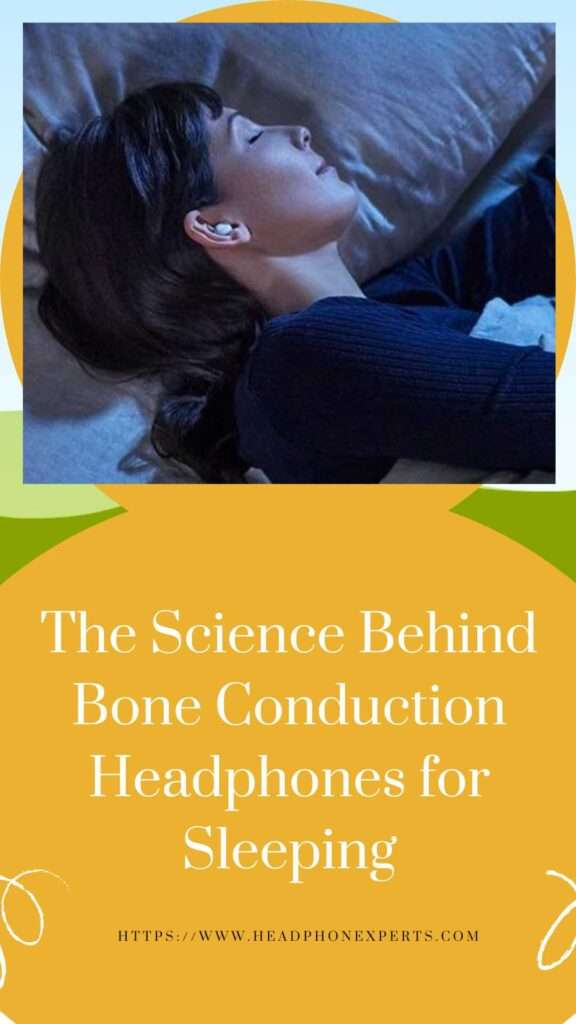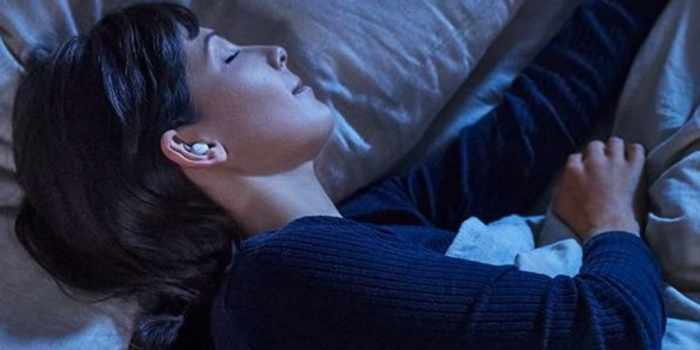With the cutting-edge world of bone conduction technology, you can discover the secrets of peaceful sleep. Exploring the science behind these cutting-edge sleep headphones takes us on a journey where music meets physiology. This amazing fusion enables you to enjoy musical nirvana without sacrificing comfort.
As we explore the complexities of bone conduction, we’ll see how these headphones are redefining the geography of nocturnal soundscapes, offering a one-of-a-kind audio experience designed for quiet nights
Best The Science Behind Bone Conduction Headphones for Sleeping reveals the peaceful intersection of science and tranquillity in the field of sleep technology.
The Science Behind Bone Conduction Headphones: A Guide to Better Sleep
in this Topic we will cover:-
- How do Bone Conduction Headphones Work?
- Best Bone Conduction Headphones for Sleeping
- How to Wear Bone Conduction Headphones for Sleeping
1.How do Bone Conduction Headphones Work?

Bone conduction headphones operate on a unique principle that sets them apart from traditional audio devices. Instead of using speakers to emit sound waves directly into the ear canal, bone conduction headphones transmit vibrations through the bones of the skull to reach the inner ear.
This process bypasses the eardrum, allowing users to perceive sound without blocking their ear canals.
The headphones typically feature transducers or bone conduction transducers, which convert electrical signals into vibrations. These vibrations then travel through the cheekbones and jawbone, eventually reaching the cochlea the organ responsible for hearing.
This innovative technology enables users to enjoy audio content while maintaining awareness of their surroundings.
Benefits of Bone Conduction Headphones
Open-Ear Design:
Bone conduction headphones leave the ear canal open, making them an excellent choice for individuals who want to stay connected with their environment. This design is particularly beneficial for outdoor activities such as running or cycling, where situational awareness is crucial for safety.
Hearing Impairment:
For individuals with certain types of hearing loss, bone conduction headphones can be a game-changer. Since they bypass the eardrum, they can transmit sound directly to the inner ear, providing an alternative for those with conductive hearing loss.
Comfort and Hygiene:
As bone conduction headphones don’t go inside the ear, they eliminate discomfort associated with prolonged use. Additionally, this design reduces the risk of ear infections, making them a hygienic choice, especially for individuals prone to such issues.
Multifunctionality:
Bone conduction headphones are popular among athletes and outdoor enthusiasts. They allow users to enjoy music or take calls while engaging in physical activities without compromising on safety.
Drawbacks of Bone Conduction Headphones
Sound Quality:
Bone conduction technology often faces challenges in delivering the same audio fidelity as traditional headphones. The sound might lack the depth and richness that some audiophiles seek.
Ambient Noise:
While the open-ear design enhances situational awareness, it can also lead to reduced isolation from ambient noise. This might be a drawback for users who prefer complete immersion in their audio content.
Limited Bass Response:
Due to the nature of bone conduction, the headphones may struggle to reproduce deep bass frequencies effectively. This limitation can impact the overall listening experience, especially for those who enjoy bass-heavy genres.
2. Best Bone Conduction Headphones for Sleeping
1. Aftershokz Aeropex
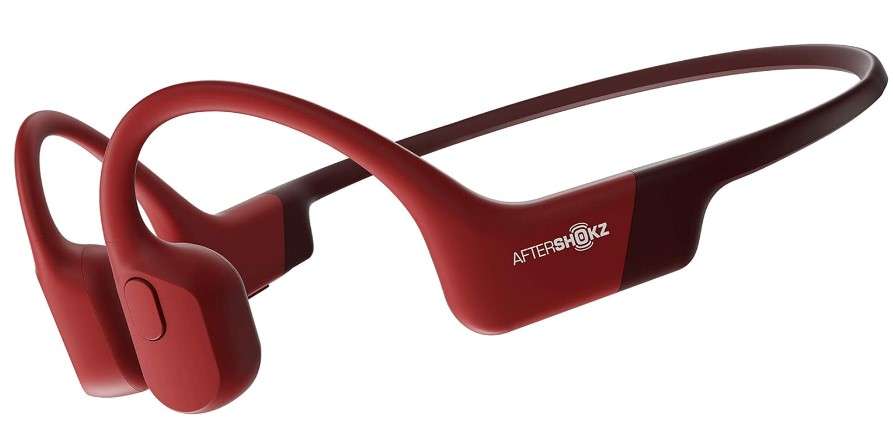
Aftershokz Aeropex is a one-of-a-kind set of bone conduction headphones that has grown in popularity due to their revolutionary design and adaptability for a variety of activities, including sleeping.
Unlike standard headphones, which employ speakers within or above the ears, bone conduction technology uses vibrations to send sound directly to the cheekbones, leaving the ears open to ambient sounds.
This is especially useful for those who want to listen to audio while sleeping without jeopardizing their safety or comfort.
Pros:
- Open-Ear Design:
- The standout feature of the Aftershokz Aeropex is its open-ear design, allowing users to listen to music, podcasts, or white noise while still being aware of their surroundings. This is crucial for safety, especially if you need to stay alert to potential sounds during the night.
- Comfortable for Sleep:
- The lightweight and sleek design of the Aeropex make them suitable for sleeping. The absence of earbuds or over-ear cups eliminates discomfort for side sleepers, and the headphones don’t press against the head, ensuring a more comfortable sleep experience.
- Bone Conduction Technology:
- Bone conduction technology is safer for extended use during sleep compared to traditional headphones. Since it doesn’t involve inserting anything into the ear canal, there’s a reduced risk of ear irritation or damage.
- Waterproof Design:
- The Aftershokz Aeropex is designed to be waterproof, making them resilient to sweat or light moisture. This feature adds durability and ensures they can withstand various conditions, enhancing their suitability for different environments.
- Long Battery Life:
- The headphones offer a decent battery life, providing several hours of use on a single charge. This is convenient for overnight use without the worry of the headphones running out of power during the night.
Cons:
- Sound Quality:
- While bone conduction technology has improved over the years, some users may find that the sound quality doesn’t match the richness and depth of traditional headphones. Audiophiles seeking a premium audio experience might prefer conventional options.
- Limited Noise Isolation:
- The open-ear design that makes these headphones suitable for sleep also means they offer limited noise isolation. If you are in a particularly noisy environment, you may find it challenging to completely block out external sounds.
2. Bose Sport Open Earbuds
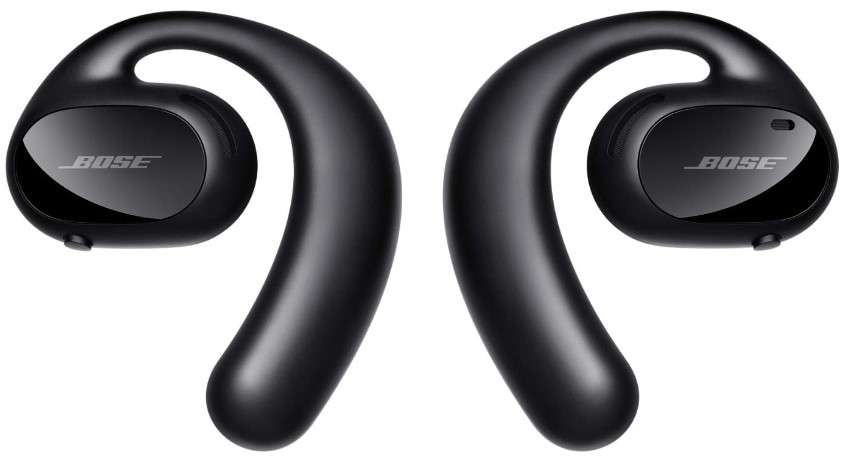
The Bose Sport Open Earbuds are a novel addition to Bose’s audio product line, designed for individuals looking for an alternative to traditional in-ear or over-ear headphones.
These open-ear buds prioritize comfort and situational awareness, making them ideal for a variety of activities, including sleep.
The lack of in-ear tips lets users to stay aware of their surroundings while listening to audio content, and the design reduces the danger of ear fatigue during extended use.
Pros:
- Open-Ear Design: The most distinctive feature of the Bose Sport Open Earbuds is their open-ear design, which ensures that users do not need to insert ear tips into their ear canals. This makes them comfortable for long-term wear and ideal for those who find in-ear headphones uncomfortable for sleeping.
- Comfortable for Sleep: The open-ear concept makes these buds comfortable for side sleepers, as they don’t create pressure points or discomfort in the ears. The absence of ear tips eliminates the need for adjusting or readjusting the buds during the night.
- Situational Awareness: With an open-ear design, users can maintain awareness of their surroundings, which is crucial, especially when using headphones in environments where external sounds need to be heard, such as during sleep or while exercising outdoors.
- Stable Fit: The Bose Sport Open Earbuds are designed to stay securely in place during various activities, preventing them from falling off during sleep or movement.
Cons:
- Limited Noise Isolation: The open-ear design inherently provides less noise isolation compared to traditional in-ear or over-ear headphones. While this is intentional for situational awareness, it may not be suitable for individuals seeking complete noise isolation for a more immersive audio experience.
- Sound Leakage: Due to the open design, sound may leak out, potentially disturbing others nearby. This could be a consideration for those sharing a sleeping space with someone else.
3. OUFUNI Bone Conduction Headphones
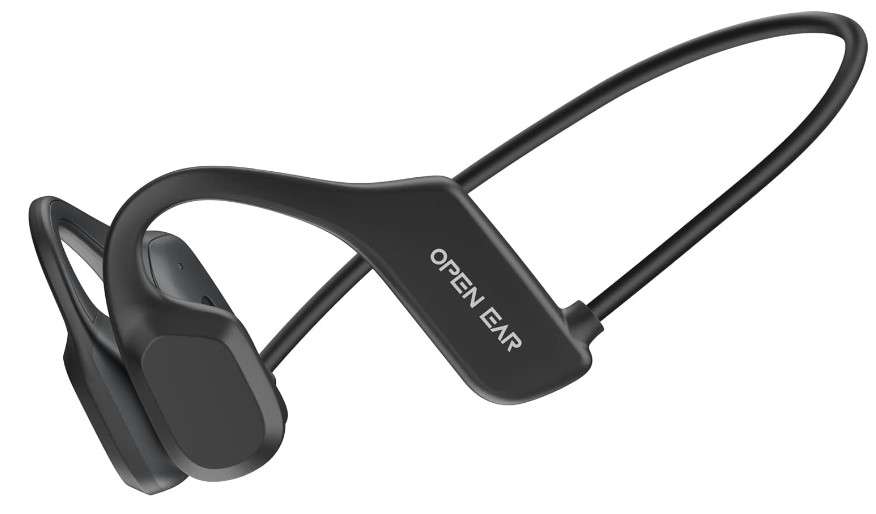
OUFUNI Bone Conduction Headphones provide a unique and revolutionary audio consumption option, particularly during sleep.
Unlike standard headphones, which employ speakers to transfer sound directly into the ears, bone conduction technology bypasses the ear canal by transmitting vibrations through the cheekbones to the inner ear.
This makes OUFUNI headphones ideal for those who want to enjoy audio material while leaving their ears unblocked, making them an appealing alternative for people looking for a comfortable audio experience while sleeping.
Pros:
- Comfortable Design for Sleep: OUFUNI Bone Conduction Headphones are designed to be worn around the temples, allowing users to comfortably lie on their sides without any earbuds digging into the ears. This makes them an excellent choice for those who want to enjoy music, podcasts, or white noise while falling asleep.
- Open Ear Concept: Unlike traditional headphones that isolate users from the external environment, bone conduction headphones keep the ears open. This can be beneficial for individuals who need to stay alert to their surroundings, such as parents listening for a baby or individuals who want to be aware of potential alarms during sleep.
- Reduced Ear Fatigue: Since these headphones don’t go inside the ear, users may experience less ear fatigue over extended periods. This makes them suitable for all-night use without causing discomfort often associated with in-ear or over-ear headphones.
- Versatility: OUFUNI Bone Conduction Headphones can be used for more than just sleep. They are suitable for outdoor activities like running or cycling, where situational awareness is crucial, as they allow users to hear ambient sounds while enjoying audio content.
Cons:
- Sound Quality Limitations: Bone conduction technology tends to offer lower audio quality compared to traditional headphones. While suitable for spoken audio and ambient music, audiophiles may find the sound lacking in richness and depth.
- Limited Noise Isolation: The open ear design means that noise isolation is limited. For users in noisy environments, this may result in a less immersive audio experience compared to traditional closed-back headphones.

3. How to Wear Bone Conduction Headphones for Sleeping

Bone conduction headphones offer a unique way to enjoy music or audio content without covering or inserting anything into your ears.
This makes them an excellent choice for those who want to listen to soothing sounds or music while falling asleep. To make the most out of your bone conduction headphones during sleep, follow these tips:
Position the Headphones Correctly:
- Place the transducers (the vibrating elements of the headphones) just in front of your ears, on the cheekbones.
- Ensure a snug fit but avoid excessive pressure. The goal is to have them securely in place without causing discomfort.
- Adjust the band around the back of your head to ensure a stable and comfortable position.
Experiment with Different Sleeping Positions:
- Side sleeping is often the most comfortable position with bone conduction headphones. This allows the headphones to maintain good contact with your cheekbones.
- Experiment with slight adjustments to the headband or earpieces to find the most comfortable and secure fit in different sleeping positions.
- Avoid pressing the headphones too hard against the pillow, as this might affect the audio quality and your overall comfort.
Troubleshooting:
- Adjusting Band Tension: If the band is too tight or too loose, it can affect both comfort and audio quality. Experiment with different tensions until you find the one that feels secure without causing discomfort.
- Cleanliness: Keep the transducers clean, as any buildup of oils, sweat, or debris can impact performance. Use a gentle cloth or cotton swab to clean them regularly.
- Battery Check: Ensure the headphones have sufficient battery life before bedtime. A low battery might result in diminished audio quality or interruptions during the night.
- Audio Source Placement: If you’re using a separate audio device, position it close enough to the headphones to maintain a stable Bluetooth connection. This prevents audio dropouts that can be disruptive during sleep.
Frequently Asked Questions
1 Are bone conduction headphones good for sleeping?
Bone conduction headphones can be a suitable choice for some people who prefer to listen to soothing sounds or white noise while sleeping. Since these headphones don’t cover or go inside the ears, they are less likely to cause discomfort during extended use.
Moreover, they allow users to maintain awareness of their surroundings, which can be important for safety reasons. Additionally, the bone conduction technology bypasses the ear canal, reducing the risk of ear-related issues often associated with traditional headphones.
However, it’s crucial to note that individual preferences vary, and while some may find bone conduction headphones comfortable for sleeping, others may prefer other options like over-ear or in-ear headphones.
2 What is the downside of bone conduction headphones?
Despite their advantages, bone conduction headphones do have some limitations. One downside is that the sound quality may not be as immersive compared to traditional headphones. Since the vibrations transmit through the bones of the face, the audio experience might lack the depth and richness that some audiophiles seek.
Additionally, in noisy environments, external sounds may interfere with the bone conduction technology, affecting the overall listening experience. While they’re great for maintaining situational awareness, this can be a drawback when trying to enjoy music or podcasts in a noisy setting.
3 Why are bone conduction headphones not popular?
Bone conduction headphones have yet to achieve widespread popularity due to a combination of factors. One key factor is the sound quality limitation mentioned earlier.
Audiophiles and music enthusiasts often prioritize high-fidelity audio, and bone conduction technology, while improving, may not yet meet those expectations.
Moreover, the design of bone conduction headphones can be perceived as less stylish compared to traditional headphones. The open-ear design and the need for transducers near the ears may result in bulkier and less aesthetically pleasing designs.
Lastly, awareness and education about bone conduction technology may be lacking. Many consumers are more familiar with traditional headphone types, and the benefits of bone conduction headphones are not as widely known.
conclusion
In conclusion, the physics of bone conduction headphones for sleeping offers an intriguing combination of technology and comfort.
These headphones, which transmit sound via bone vibrations rather than typical auditory pathways, provide a unique alternative for people looking for a non-intrusive way to listen to audio content while sleeping.
The open-ear design not only improves comfort, but it also tackles ear-related discomfort, which is commonly linked with standard headphones.
While bone conduction headphones are an innovative method, there are several things to bear in mind. The sacrifice in sound quality, while acceptable for many users, may not please audiophiles looking for an immersive audio environment.
Furthermore, the adoption of bone conduction headphones is hampered by factors such as aesthetics, with some finding the designs less appealing than traditional alternatives, as well as a general lack of awareness and education about this breakthrough technology.
